In 1805, wealthy businessman Joseph Williamson acquired land in Mason Street, Edge Hill, Liverpool, which was then largely undeveloped sandstone dotted with small trees. The land was placed under the lease of the West Derby Waste Commissioners, who retained the rights to the minerals in it: Williamson began to build a house on the site, which connected the growing area with the fashion of Liverpool. According to the report of the 19th century Liverpool antiquarian, James Stonehouse, these houses are of eccentric design and "the most fantastic detail" without any plan. The land behind them fell away, and in order to provide a large garden, Williamson built a terrace that could extend the gardens. He went on to build and modify several other buildings on the site during that time, including the mansion on Mason Street that he and his wife lived in. To carry out the work, he received a large pool of poor and poor areas, including soldiers left unemployed at the end of the Napoleonic Wars; according to Stonehouse, he sometimes employed them to do menial tasks, such as moving rubble from one place to another and back again.

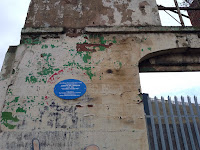
Joseph Williams, house on Mason Street
Meanwhile, for a couple of hundred years, the tunnels have been buried. They were filled in after locals complained about the smell - apparently the cave had long been used as an underground dump and filled with everything from household waste to human waste.
At the same time, his workers also dug many brick tunnels and various deep holes in the sandstone. They covered a wide area, extending to the limits of the Williamson lease and possibly beyond. Stonehouse, who visited part of the tunnels in 1845, described the excavation as a maze of "vaulted [...] deep passages and gaping chasms", including a "horrific hole" below Grinfield Street and two fourth buildings
The purpose of the excavations has been the subject of much debate. As Stonehouse's most recent novel, Williamson was secretive about his intentions, leading to many urban legends. When he learned that Stonehouse planned to publish his research on Williamson's excavations, Williamson's friend, artist Cornelius Henderson, threatened to sue Stonehouse for both libel and infringement, which led to the publication of the journal for several years.
A common explanation is that it is a charity. Williamson's own explanation was that his intention was "the work of the poor"; Its workers "receive a weekly wage and can enjoy the blessings of charity without the accompanying curse of self-respect". Some features of the tunnels seem to support this theory; There are many home plans that appear to be ostentatious decorations, hidden underground in rooms that may be dimly lit. For example, at the Mason Street site, a well-constructed stone pavement was recently found in a simple sided building in the ground, with no clear explanation of its purpose. These characteristics can be explained as Williamson helps his employees to improve their skills.


Another suggestion, that he was a religious extremist who feared the end of the world was near and that the tunnels were built to escape him and his friends, has recently been raised by 'soft plan made in TV show. No evidence has been found to support the existence of such a group or that Williamson, who used to be a member of the Church of England, was a member.
Source: Hand, C. R. (1916),
source: Quoted in Whittington-Egan 1985, p. 9.
The whole area is bisected by the railway cutting and the long dark tunnel running left to right across much of the image is the ‘Triple Decker’ tunnel. They also drew a cross section view, showing the different layers. Note the famous ‘double tunnel’ on the right, which is accessible today.
The Friends of Williamson's Tunnels (FoWT) is a registered charity, run by a group of leaders and engaged in the exploration, excavation and conservation of tunnels, run by volunteer miners.
FoWT's main location on Mason Street is the site of Joseph Williamson's house, which has been largely demolished except for a small part of the facade that still stands. However, the excavations there have revealed many underground areas, as well as many tunnels in different directions and at different depths. In the basement is a large room known as the "Banqueting Hall", which takes its name from the oft-repeated story of Williamson throwing huge parties for his staunchest friends. 'something, although it is unlikely that the opportunity was used for this. purpose. Since 2019, the "hotel" has been completely destroyed, but excavations continue in the newly discovered tunnel leading to the main room. The second part of the tunnel can be accessed from the "Paddington" site, which has several underground shops, leading to a large room about 40 feet (12 m) high. from floor to ceiling. The floor of this building is about 60 feet (18 m) below ground level and was excavated in 2016 after years of excavation.
The sites have been used as filming locations and have appeared in many magazines featuring FoWT channels and volunteers. This group has been featured in many news reports, including national television channels such as the BBC and ITV.
source: Introduction/FAQ, Friends Of Williamson's Tunnels, 4 October 2015, retrieved 23 June 2019
This narrow section is known as the 'Gash' a narrow gap 150ft below..
https://www.derelictmanchester.com/2022/11/williamson-tunnel








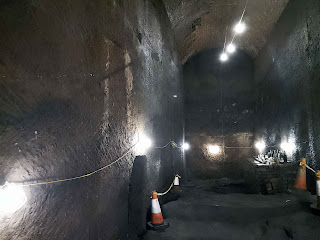







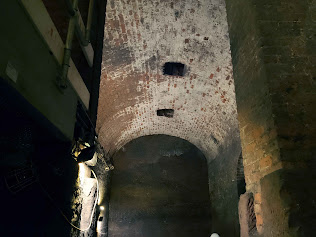



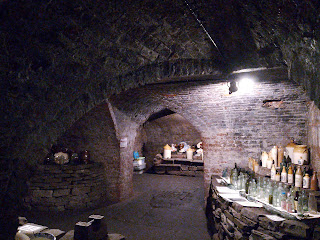

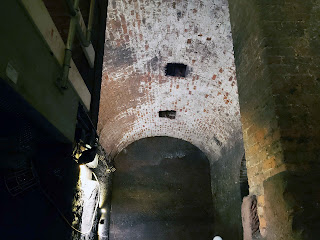

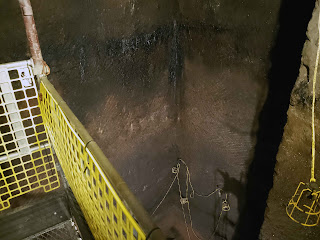


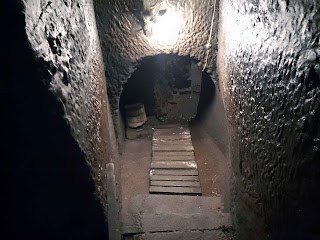




























No comments:
Post a Comment